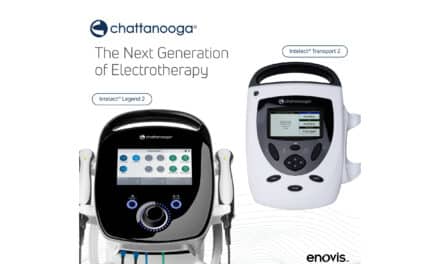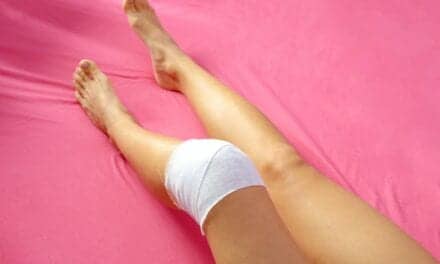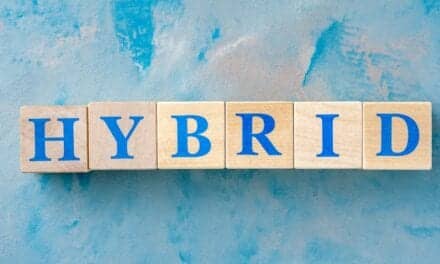By Sarah DoBroka, PT, SCS, COMT
Pain is the communication method the body uses to indicate that something is wrong within a system. Given the choice, most people would elect to avoid pain’s unpleasant sensations, which can range from mild and occasional to sheer agony and unrelentingly constant. Pain can be localized to a discrete area or diffuse region, can appear suddenly or come about slowly, and can be acute or chronic. Acute pain begins suddenly and usually disappears when the underlying cause of pain has been treated or has healed. Common examples of orthopedic acute pain are broken bones, tissue trauma, and surgery. When the pain signals remain active in the nervous system despite healing of an injury, or when there is an ongoing cause of pain, acute pain may lead to chronic pain. Chronic pain can affect a person for weeks, months, or years. Physical effects can manifest as, but aren’t limited to, headaches, low back and neck pain, or arthritic and neurogenic pain.

Class 1M LLLT utilizes red/infrared light to relieve pain, accelerate tissue repair/healing, and decrease inflammation. Treatment with laser therapy is not based on heat development, but on photochemical and photobiological effects in cells and tissues.
According to the National Institutes of health (NIH), greater than 76 million people in the United States live with chronic pain, and over half will not receive treatment. For those who do seek treatment within the healthcare system, many different options are available. The most common treatments utilized are pharmacological (NSAIDS, Tylenol, narcotics), localized anesthetics, nerve blocks, surgery, relaxation techniques, behavior modification, and physical therapy. Physical therapists are uniquely trained to treat pain in a variety of ways using manual techniques, exercise, movement correction techniques, and modalities/tools. This article focuses on the variety of modalities and tools PTs at OrthoCarolina may successfully use in the outpatient orthopedic clinic to treat commonly seen pain diagnoses.
The Orthopedic Pain Management Toolbox
TENS and Interferential current (IFC): Both forms of electrical stimulation are used at the sensory level to decrease pain. Higher frequencies are utilized to stimulate pain gate mechanisms that mask the pain symptoms. Alternatively, stimulating lower frequencies can be used to activate the opioid mechanisms, again providing a degree of relief. IFC offers a greater depth of penetration and can have a better post treatment carryover of pain relief than TENS. The Empi Select TENS from DJO Global, Vista, Calif, is a pain management tool commonly used by therapists in the OrthoCarolina outpatient clinic. Other devices available to the market are the TENS 5 and EMS 5 from Zimmer MedizinSysteme, Irvine, Calif, both of which are compact and battery operated. Mettler Electronics, Anaheim, Calif, offers multiple devices in this category, including the TENS*STIM 211, Trio*Stim, TENS 210, and TENS 212, all of which have two channels and are built to be compact and portable.
Ultrasound: Ultrasound uses sound waves that pass through skin and cause a vibration or cavitation of local tissues to promote tissue relaxation, increase local blood flow, and increase scar tissue breakdown. Ultrasound can be transmitted pulsed for non-thermal effects, or continuously for thermal effects. Phonophoresis is a method that administers medication, such as Fluocinonide, to tissues below the skin in a noninvasive way. Several manufacturers offer ultrasound devices for use in the physical therapy setting. Two devices manufactured by Chattanooga, a DJO Global company, Vista, Calif, are used to provide ultrasound and electrical stimulation in the outpatient clinic: the Vectra Genisys Therapy System and the Intelect Legend XT. The Genisys consolidates up to six therapeutic modalities in a single system. The Intelect Legend XT offers two independent electrotherapy channels that can be expanded to four. Also available to the physical therapy clinic is the Therasound EVO from Chattanooga, Tenn-based Richmar, offering dual-frequency clinical ultrasound in continuous or pulsed ultrasound duty cycles.
Iontophoresis: Iontophoresis is a type of electrical stimulation that is used to administer medication into the body through the skin to decrease inflammation, decrease pain, decrease swelling/edema, reduce calcium deposits, and manage scar tissue. Common medications utilized are Dexamethasone, Acetic Acid, and Potassium Iodide. The Iomed Phoresor II Auto from Isokinetics Inc, De Queen, Ark, is an iontophoresis tool used among therapists at this facility’s clinic in the management of pain symptoms.
H-Wave: The H-Wave device is an electro therapeutic treatment that utilizes lower voltage and has ultra-low and high frequency stimulation options. The ability to use both frequencies simultaneously during one session, combined with the low voltage, promotes improved fluid dynamics, pain control, and aids in functional restoration. The device, which is another tool used by therapists in the outpatient clinic, is available from Electronic Waveform Lab Inc, Huntington Beach, Calif.
Low Level Laser Therapy (LLLT): Class 1M LLLT utilizes red/infrared light to relieve pain, accelerate tissue repair/healing, and decrease inflammation. Treatment with laser therapy is not based on heat development, but on photochemical and photobiological effects in cells and tissues. Super-pulsed laser provides the deepest penetration in the therapeutic window and produces higher peak power, leading to higher energy densities without thermal buildup in cells and tissues.
[sidebar float=”right” width=”250″]Product Resources
The following companies provide products for pain management:
Battle Creek Equipment Company
www.battlecreekequipment.com
Biofreeze/Performance Health
www.biofreeze.com
Chattanooga, a DJO Company
www.djoglobal.com/our-brands/chattanooga
Everyway4all
www.everyway4all.com
E-Z Release Myofascial Technique
(831) 620-0744
Mettler Electronics
www.mettlerelectronics.com
Parker Laboratories
www.parkerlabs.com
Richmar
www.richmarweb.com
Sombra Professional Therapy Products
www.sombrausa.com
Sore No More
www.sorenomore.com
Southwest Technologies
www.elastogel.com
Zimmer MedizinSystems
www.zimmerusa.com[/sidebar]
Beyond Electro Modalities
Instrument Assisted Soft Tissue Mobilization (IASTM): IASTM is a noninvasive treatment involving specialized instruments to detect and treat fascial dysfunction with the goal of stimulating an inflammatory healing response. Using an instrument magnifies the fascial abnormalities and focuses the force through an area smaller than the fingers with less friction, which allows a more efficient treatment.
Dry Needling/Intramuscular Manual Therapy (IMT): This technique uses a thin filiform needle, without medication, to penetrate the skin and stimulate underlying myofascial trigger points, muscular tissues, and connective tissues for the management of neuromusculoskeletal pain and movement impairments.
Kinesio Taping: This taping technique is designed to facilitate the body’s natural healing process while providing support and stability to muscles and joints without restricting the body’s range of motion. Other benefits include extending soft tissue manipulation to prolong the benefits of manual therapy administered in the clinical setting, alleviation of discomfort, and facilitation of lymphatic drainage by microscopically lifting the skin. Tape is specifically cut and applied based on patient needs after clinical evaluation. Kinesio Holding Corporation, Albuquerque, NM, manufactures Kinesio Tapes in several styles, including pre-cut products, for a variety of therapeutic applications. Tape most frequently used in this clinic is Kinesio Tex Gold.

Sarah DoBroka, PT,SCS,COMT,Cert DN, applies therapeutic tape specifically cut and applied based on patient needs.
Heat Therapy: Heat is a noninvasive pain relief therapy that causes vasodilation, which increases blood flow, supplies oxygen and nutrients to decrease pain in joints, and relaxes sore muscles. Warmth can also decrease muscle spasms and increase range of motion. Heat can be dry or moist, and is most beneficial with stiff joints or chronic muscle/joint pain. Elastogel, based in North Kansas City, Mo, offers a line of wraps in a variety of sizes contoured for a comfortable fit that can be heated or cooled to provide the desired therapeutic effects.
Cold Therapy: Application of cold therapy results in vasoconstriction, causing decreased blood flow to an area, decreased pain and swelling, decreased muscle spasms, and decreased inflammation. Cold is recommended for the first 48 hours postinjury for sprains, strains, bruises, and postoperative treatments. Ice and gel packs are all examples of effective cold therapies. Another cold therapy technology OrthoCarolina therapists use is the Game Ready vasopneumatic compression. This device, manufactured by CoolSystems Inc, Concord, Calif, progressively increases and releases pressure while rapidly circulating ice water through separate wrap chambers. This integrated system allows therapists to simultaneously apply active compression and adjustable cold to reduce swelling and promote natural healing.
Topical Analgesics: Used for the temporary relief of minor aches and pains, topical analgesics compose a category of pain management products that are affordable, easy to use, and offered in a variety of forms that includes creams, sprays, and gels. Sore No More from Moab, Utah-based Sore No More, and Sombra Natural Pain Relieving Gels from Sombra Professional Therapy Products, Albuquerque, NM, are two gel pain relievers formulated with natural ingredients that can be used in the home or clinic. Another topical pain reliever is Flexall from Tempe, Ariz-headquartered Ari-Med Pharmaceuticals, which applies as a gel and is available in professional sizes.
Finding What Fits: Clinical Applications
An extensive pain management toolbox gives the outpatient orthopedic clinician a wide variety of options to treat various types of pain. While research hasn’t always supported the use of modalities, based on clinical experience, education, and available resources, some therapists develop an affinity toward a specific modality, or they find that certain modalities are more effective and/or efficient than others. At OrthoCarolina, therapists have access to the entire aforementioned toolbox to treat common orthopedic diagnoses such as neck and back pain, joint replacements, arthritis flare-ups, and a variety of sports injuries. While each patient is evaluated and given a specific treatment plan, there is a modality or grouping of modalities that can have a positive effect on each type of diagnosis.
Arthritis Pain: Arthritic flare-ups respond well to heat therapy, any form of electrical stimulation, and LLLT.
Chronic Pain: For patients presenting with chronic neck and back pain, any form of electrical stimulation, hot and cold therapies, or dry needling are preferred. LLLT is effective especially when nerve pain is present. Some therapists find that Kinesio taping is more effective in the neck than in the lower back region.
Joint Replacements: Postop joint replacement patients struggle with pain from surgery and resulting inflammation and stiffness. Cold therapy LLLT, Kinesio taping, and H-wave are preferred modalities for inflammation. Pulsed ultrasound and LLLT are used for instances of severe postop bruising, while performing IASTM or dry needling on surrounding tissues may improve feelings of stiffness.
Sports Injury Pain: When treating injured athletes, the depth of a PT’s toolbox provides options for every modality, depending on the specific need. Small, isolated areas of inflammation may respond well to iontophoresis or phonophoresis. Larger regions of swelling will benefit from LLLT, H-Wave, Kinesio taping, and cold therapy. Pain from myofascial restrictions will improve with IASTM, dry needling, and Kinesio taping. Higher-frequency electrical stimulation is preferred with more acute pain from surgery or on-field injury.
Physical Therapy as the Pain Avenger
As the annual economic cost of treating pain continues to rise and insurance companies have continued to limit visits, the importance of efficient and effective pain management within the context of a holistic approach to treating each individual cannot be underestimated. Modalities are physical agents that can greatly augment the healing process and produce desired pain-relieving effects. As physical therapists evaluate and develop the overall plan for return to normal function or athletic competition for the orthopedic patient presenting with pain, the inclusion of modalities in their toolbox as an adjunct treatment is important and almost always indicated. PTP
Sarah DoBroka, PT, SCS, COMT, is a physical therapist with OrthoCarolina. She has more than 14 years of clinical experience, including university settings, outpatient clinics, sideline coverage, and hospital settings. DoBroka specializes in a comprehensive treatment approach to orthopedic injuries in athletes of all ages (including interscholastic, collegiate, and professional) as well as weekend warriors. For more information, contact [email protected].






